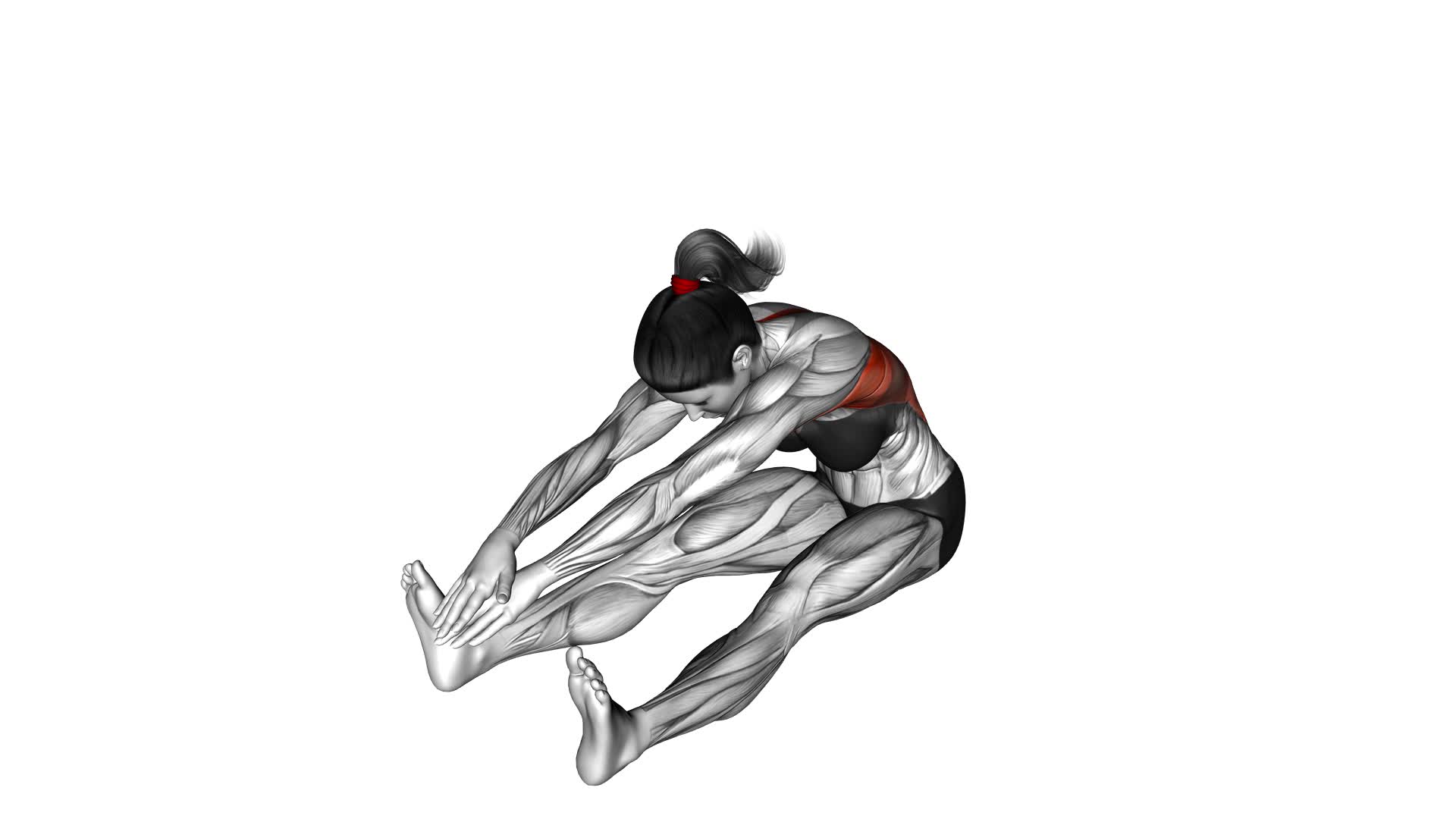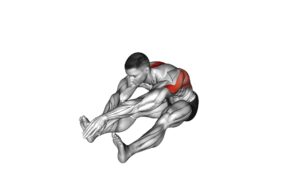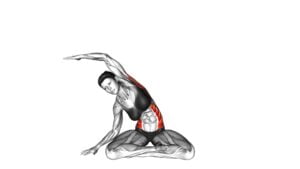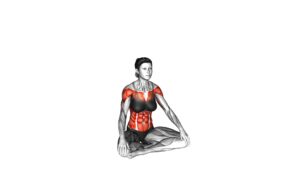Sitting Bent Over Back Stretch (female) – Video Exercise Guide & Tips

In this video exercise guide, you'll learn all about the Sitting Bent Over Back Stretch specifically designed for females. This stretch offers numerous benefits for your back and overall flexibility.
Watch This Exercise Video
You'll discover the proper form and technique to maximize the effectiveness of the stretch, along with modifications for both beginners and advanced practitioners.
We'll also cover common mistakes to avoid and provide safety precautions for a safe and successful stretching session.
Get ready to improve your flexibility and strengthen your back!
Key Takeaways
- Improves flexibility and mobility in the back muscles
- Alleviates tension and tightness in the back
- Promotes better posture
- Reduces the risk of back pain
Benefits of the Sitting Bent Over Back Stretch
Experience the numerous benefits of the Sitting Bent Over Back Stretch. This exercise is highly beneficial for improving flexibility and mobility in your back muscles. By practicing this stretch regularly, you can alleviate tension and tightness in your back, promoting better posture and reducing the risk of back pain.
One of the key benefits of the Sitting Bent Over Back Stretch is its ability to stretch and lengthen the muscles of your lower back. This helps to relieve any stiffness or discomfort caused by prolonged periods of sitting or inactivity. Additionally, this stretch also targets the muscles in your upper back, shoulders, and neck, promoting overall upper body relaxation.
To perform the Sitting Bent Over Back Stretch with proper form, start by sitting on the edge of a chair with your feet flat on the floor. Slowly bend forward from your hips, keeping your back straight and your neck relaxed. Reach your hands towards the floor or try to touch your toes, depending on your flexibility level. Hold this position for 20-30 seconds while focusing on deep breathing.
Incorporating the Sitting Bent Over Back Stretch into your daily routine can improve your spinal flexibility, relieve back tension, and promote better posture. Remember to always perform this stretch with proper form to maximize its benefits and avoid any potential injuries.
Proper Form and Technique for the Stretch
To properly perform the Sitting Bent Over Back Stretch, you should maintain a straight back and relaxed neck as you slowly bend forward from your hips, reaching towards the floor or your toes, depending on your flexibility level. This stretch is often misunderstood, so it's important to clarify some common misconceptions.
First, it's essential to remember that this stretch primarily targets the hamstrings and lower back, not the upper back. Many people mistakenly believe that rounding the upper back is part of the proper form, but this can actually lead to poor posture and potential injury. Instead, focus on keeping the spine straight and lengthened throughout the stretch.
There are also variations and alternatives to consider when performing this stretch. If you have limited flexibility, you can bend your knees slightly to reduce the strain on the hamstrings. Another option is to use a yoga block or a rolled-up towel under your hands to elevate the floor and make the stretch more accessible.
Remember to listen to your body and only go as far as feels comfortable for you. It's important to avoid any pain or discomfort during the stretch. If you experience any sharp or intense pain, stop immediately and consult a healthcare professional.
Modifications for Beginners and Advanced Practitioners
To modify the Sitting Bent Over Back Stretch for beginners and advanced practitioners, try incorporating variations that suit your level of flexibility and strength.
For beginners, it's important to start slowly and focus on proper form to avoid injury. If you find it difficult to reach your toes while sitting with your legs extended, you can use a strap or towel to assist you. Simply wrap the strap around the balls of your feet and hold onto the ends with your hands. This will provide some extra support and help you gradually increase your flexibility over time.
For advanced practitioners, you can challenge yourself by adding a twist to the stretch. After reaching forward with both hands towards your toes, slowly twist your torso to one side, bringing one arm up towards the ceiling. Hold this position for a few breaths, feeling the stretch in your back and obliques. Then, return to the center and repeat on the other side.
Another advanced variation is to lift one leg off the ground while in the forward fold position. This will intensify the stretch in your hamstrings and lower back. Remember to keep your core engaged and your back straight as you perform this variation.
Common Mistakes to Avoid While Performing the Stretch
To perform the Sitting Bent Over Back Stretch correctly, it's important to maintain proper body alignment. Avoid rounding your back or hunching your shoulders, as this can lead to strain or injury.
Additionally, pay attention to your breathing technique, inhaling deeply as you prepare to stretch and exhaling as you relax into the stretch.
Proper Body Alignment
To maintain proper body alignment during the sitting bent over back stretch, avoid these common mistakes.
First, make sure to maintain good body posture throughout the exercise. Keep your back straight and shoulders relaxed, avoiding any hunching or slouching. This will help to properly align your spine and prevent unnecessary strain on your back muscles.
Additionally, be mindful of your head position. Keep it in line with your spine, avoiding any excessive tilting or dropping. Remember, proper body alignment is crucial in order to maximize the benefits of the stretch and minimize the risk of injury.
Now that you understand the importance of body alignment, let's move on to the next section and discuss the breathing techniques to enhance the effectiveness of the sitting bent over back stretch.
Breathing Techniques
Take deep breaths during the sitting bent over back stretch to enhance the effectiveness of the exercise and avoid common mistakes. Proper breathing techniques can help you relax your body and mind, allowing for a deeper stretch and improved flexibility.
As you begin the stretch, inhale deeply through your nose, filling your lungs with air. As you exhale, slowly bend forward, focusing on elongating your spine and reaching towards your toes. Take another deep breath in this position, feeling the stretch in your back. Exhale as you release the stretch and return to the starting position.
Remember to breathe deeply and rhythmically throughout the entire exercise, allowing for a sense of calm and relaxation. By incorporating proper breathing techniques, you can maximize the benefits of the sitting bent over back stretch.
Now, let's move on to the next section and explore gradual progression tips for this exercise.
Gradual Progression Tips
Start by gradually increasing the depth of your forward bend to avoid straining your muscles or causing discomfort. Remember to listen to your body and stop if you experience any pain.
As you progress, you can modify the stretch by placing a yoga block or folded blanket under your hips to support your lower back. This will allow you to go deeper into the stretch without compromising your form.
Additionally, focus on your breathing techniques while performing the stretch. Take slow, deep breaths, inhaling as you lengthen your spine and exhaling as you fold forward. This will help you relax and release any tension in your muscles.
The gradual progression and proper breathing techniques will provide numerous benefits, including improved flexibility, reduced back pain, and enhanced posture.
Tips for Maximizing the Effectiveness of the Stretch
Position your body correctly to ensure maximum effectiveness of the sitting bent over back stretch. By following these tips, you can maximize your results while minimizing the risk of injuries.
First, sit on a mat or a comfortable surface with your legs extended in front of you. Keep your spine straight and your shoulders relaxed. It's important to maintain good posture throughout the stretch to avoid straining your back or neck.
Next, slowly begin to bend forward from your hips, reaching towards your toes. Keep your back straight as you lower your upper body towards your legs. Engage your core muscles to support your spine and prevent any excessive rounding of the back.
As you reach your maximum stretch, hold the position for about 20-30 seconds, breathing deeply and allowing your body to relax into the stretch. Remember not to push yourself too hard, as overstretching can lead to injuries.
To enhance the effectiveness of the stretch, imagine lengthening your spine with each breath you take. Visualize your back muscles gently stretching and releasing any tension.
Finally, when releasing the stretch, do so slowly and with control. Gradually sit up and return to the starting position.
Safety Precautions and Considerations for Females
When performing the Sitting Bent Over Back Stretch, there are a few safety precautions and considerations that you should keep in mind as a female.
First, it's important to choose clothing and equipment that allows for a full range of motion and provides adequate support.
Additionally, be aware of your surroundings and ensure you have enough space to perform the exercise safely without any obstacles or hazards.
Clothing and Equipment Choices
How can you ensure your safety and comfort during the Sitting Bent Over Back Stretch exercise as a female? Here are three important considerations to keep in mind:
- Clothing choices:
Opt for comfortable and breathable clothing that allows for a full range of motion. Avoid tight or restrictive garments that may limit your flexibility or cause discomfort during the exercise. Additionally, wearing a supportive sports bra can provide added comfort and stability.
- Equipment options:
While this exercise can be performed without any equipment, using a yoga mat or an exercise mat can provide extra cushioning and grip. This can help prevent any discomfort or slipping during the exercise. If you prefer to use props, a yoga block can be used to modify the stretch and make it more accessible for individuals with limited flexibility.
- Safety precautions:
Maintain proper form throughout the exercise to avoid strain or injury. Keep your back straight and engage your core muscles to support your spine. If you experience any pain or discomfort, stop the exercise and consult with a healthcare professional. Listen to your body and modify the stretch as needed to ensure your safety and comfort.
Awareness of Surroundings
To ensure your safety and comfort during the Sitting Bent Over Back Stretch exercise as a female, it's important to be aware of your surroundings and take necessary precautions. Maintaining situational awareness is crucial to avoid potential risks or dangers. Before starting the exercise, find a quiet and well-lit area where you can focus without distractions. Be mindful of any objects or obstacles in your surroundings that may pose a hazard. Clear the space and create a safe environment.
Additionally, practicing mindfulness techniques can enhance your awareness and concentration. Take a moment to breathe deeply and center yourself before beginning the exercise. Stay present throughout the stretch, paying attention to any discomfort or strain. By being aware of your surroundings and practicing mindfulness, you can ensure a safe and effective workout.
Frequently Asked Questions
Can Men Also Perform the Sitting Bent Over Back Stretch?
Yes, men can also perform the sitting bent over back stretch. This stretch can help improve men's flexibility and provide several benefits.
Stretching is important for men as it helps increase range of motion, reduce muscle stiffness, and prevent injuries.
By regularly performing the sitting bent over back stretch, men can enhance their overall flexibility, promote better posture, and relieve tension in the back muscles.
Incorporating this stretch into your routine can contribute to improved physical well-being.
How Often Should I Perform the Sitting Bent Over Back Stretch for Optimal Results?
For optimal results, it's recommended that you perform the sitting bent over back stretch with a frequency of 2-3 times per week.
This exercise helps to improve flexibility and mobility in your back muscles, promoting better posture and reducing the risk of back pain.
By incorporating this stretch into your routine, you can achieve increased range of motion and overall back health.
Remember to listen to your body and adjust the frequency based on your individual needs and comfort level.
Can This Stretch Help Alleviate Lower Back Pain?
To alleviate lower back pain, incorporating the sitting bent over back stretch into your daily routine can provide numerous benefits. This stretch helps to stretch and strengthen the muscles in your lower back, promoting increased flexibility and reducing tension.
To modify the stretch for individuals with specific back conditions, it's important to consult with a healthcare professional or a licensed physical therapist. They can provide personalized guidance and recommend modifications tailored to your specific needs.
Is It Normal to Feel Discomfort or Tension During the Stretch?
Feeling discomfort or tension during a stretch isn't unusual. It's a sign that your muscles are being stretched and worked. However, it's important to distinguish between normal discomfort and pain.
If the discomfort is sharp or intense, you should stop the stretch immediately. Adjust your position to find a comfortable range of motion.
Remember to breathe deeply and relax your muscles during the stretch to minimize tension.
Are There Any Alternative Stretches That Can Complement the Sitting Bent Over Back Stretch for a Well-Rounded Stretching Routine?
When it comes to your stretching routine, it's always good to have a variety of exercises. Alternative stretches can complement the sitting bent over back stretch and give you a well-rounded routine. By incorporating different stretches, you can target different muscle groups and increase flexibility.
Some examples of alternative stretches include:
- Cat-cow stretch
- Child's pose
- Seated twist
Remember to always listen to your body and modify the stretches if needed.
Conclusion
In conclusion, the sitting bent over back stretch is a beneficial exercise for females that targets the back muscles and improves flexibility.
By following proper form and technique, beginners and advanced practitioners can modify the stretch to suit their level of flexibility.
It's important to avoid common mistakes and maximize the effectiveness of the stretch by engaging the correct muscles and maintaining a steady breathing pattern.
Safety precautions should also be considered to prevent any potential injuries.

Author
Years ago, the spark of my life’s passion ignited in my mind the moment I stepped into the local gym for the first time. The inaugural bead of perspiration, the initial endeavor, the very first surge of endorphins, and a sense of pride that washed over me post-workout marked the beginning of my deep-seated interest in strength sports, fitness, and sports nutrition. This very curiosity blossomed rapidly into a profound fascination, propelling me to earn a Master’s degree in Physical Education from the Academy of Physical Education in Krakow, followed by a Sports Manager diploma from the Jagiellonian University. My journey of growth led me to gain more specialized qualifications, such as being a certified personal trainer with a focus on sports dietetics, a lifeguard, and an instructor for wellness and corrective gymnastics. Theoretical knowledge paired seamlessly with practical experience, reinforcing my belief that the transformation of individuals under my guidance was also a reflection of my personal growth. This belief holds true even today. Each day, I strive to push the boundaries and explore new realms. These realms gently elevate me to greater heights. The unique combination of passion for my field and the continuous quest for growth fuels my drive to break new ground.







